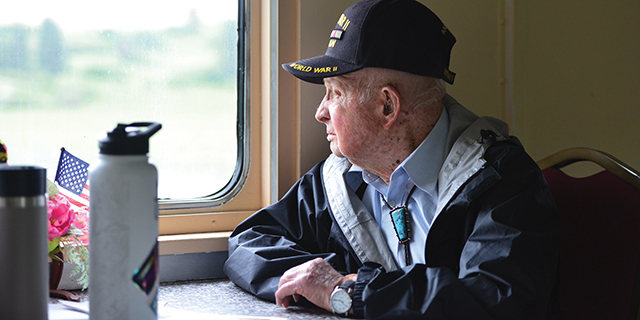‘Life’s an adventure’
Published 4:00 pm Tuesday, March 30, 2004

- Fred Boyce, left, and Michael D'Antonio share a laugh during their talk to Carol Kilpatrick's GUHS citizenship class. The two men have a remarkable rapport, having spent much time over the years piecing together D'Antonio's book,
Fred Boyce has not lived a charmed life. He was a foster child admitted to a state school where he endured 11 years of physical and psychological torture, and was the subject of scientific experimentation. He now is diagnosed with terminal cancer.
His story, which is much larger than it appears, has unfolded slowly over the years. From one article, a local Grant Union High School social studies teacher, Carol Kilpatrick, established contact seven years ago with Fred Boyce and ever since he has been a part of her life and her citizenship class. Every year Fred communicates with Kilpatrick’s students via telephone to discuss his experiences.
“I try to make leaning relevant,” she says. “Here I wanted to show the students what the government can do for you and what you can do for it through Fred. My intent has been getting the students involved with politics every moment of their waking day. One of the reasons Fred has been so successful with them is that he lives and breathes this.”
Fred’s story, and those of his friends and survivors from the school, was also picked up by Pulitzer Prize-winning journalist Michael D’Antonio. After 10 years of trying to convince publishers the story was worth telling, D’Antonio’s book titled, “The State Boys Rebellion: A True Story,” will be out in May, and the television news program “60 Minutes” will also air Fred’s story.
Just recently, Fred Boyce, Michael D’Antonio and a freelance video company on contract for 60 Minutes all converged on Grant County and in particular Grant Union High School. Fred and Michael’s names were up in lights on the Grant Union High School sign. They were greeted and cheered by the entire high school and staff, with special performances by the choir and dance team. Fred, slightly nervous and shy, spoke to the school and broke down momentarily, overwhelmed by emotions and the rapt response of the students.
His message was clear and simple: “Life is wonderful. Stay with it and do the best you can with it,” Fred said to the crowd. “Come on,” he continued in his Boston twang, “if I can do it, you guys should have no problem. Make a difference – don’t get caught up in everything. Being negative is a waste of time. If you got a problem: solve it and move on.”
Those simple and wise words from a man who was once supposedly retarded, endured 11 years of hell, and is now diagnosed with cancer.
He left the gym saying to the kids, “I thought I was pretty hip coming from Boston, but you guys are the hippest.”
After the gathering in the gym Fred, Michael and the camera crew moved to Kilpatrick’s classroom for a question and answer period with her class.
The following is Fred’s story.
By the time Fred was a mere 8 months old, he was a ward of the State of Massachusetts. His mother had little education, was poor, had trouble with alcohol and was already a widow when she was in her early 20s. Neighbors called the police after she left her two sons alone in her apartment and Fred and his brother were separated – never to see one another again.
Fred was tossed from foster home to foster home. He was deemed feebleminded, or retarded, after a battery of psychological tests and admitted in 1949 at the age of 8 to the Walter E. Fernald School for the Feebleminded, a state run residential school for retarded children in the Boston suburbs. He was not released until Feb. 9, 1960, essentially illiterate and 19 – and the release was actually a parole, where he was kept under supervision with the threat of being recommitted for any reason without a hearing.
The problem is Fred was never retarded. He was a perfectly normal kid barring the psychological effects of neglect and an unstable home life during his early childhood.
Unfortunately, being committed to a state school for retarded children was just the beginning of Fred’s horrors.
Fred was one of tens of thousands of normal children forced into hundreds of these institutions or “schools” under a national effort to “clean up” America’s gene pool. Called eugenics, this program tired to cull the lower echelons of society – the poor, the criminals, the illiterates, the immigrants. By ridding society of these unfavorables and encouraging white middle and upper class women to have large families, the numbers of upper and middle class white, Anglo Saxon Protestants would strengthen.
The lower classes were incarcerated and often sterilized. Their children and orphans were admitted to state institutions, where they endured physical, sexual and psychological abuse, neglect and experimental testing. Some institutions even went as far as lobotomizing their subjects and applying electroshock therapy to control them.
This era of eugenics began in the early 1900s and was practiced for nearly 50 years in this country. Forced sterilizations continued into the 1970s and even early ’80s in some states, including Oregon. It was the basis for Germany’s genetic ideology behind the Holocaust.
Fred outlasted his sentence at Fernald, despite the torture, abuses and neglect. He rose above the odds, taught himself to read and write, became self-educated, secured a decent living and married.
Fred recounted his emotions immediately after his release. “Free! Free at last!” he shouted explaining his first thoughts. “But I was a little nervous. I thought to myself, ‘Can I survive on the outside?’ as we called it. But it was exciting too. I had to learn how to act ‘normal’ to try and get some confidence and not feel different from other people. But learning everything was so exciting.”
But in 1993 he stumbled on a dirty little secret.
During a period at Fernald he and several other children were selected to take part in a study. Told they were selected for the study as they were special and smart and making a contribution to society, Fred and the others actually felt privileged. Their group was even given the name of the Science Club, which elevated their status in the school and among themselves. They were rewarded with trips to baseball games, even gifts.
The participants of this program were of course the doctors at Fernald, but also MIT (Massachusetts Institute of Technology), Harvard University, the Atomic Energy Commission and Quaker Oats.
Unbeknownst to the boys in the Science Club, they were in actuality part of an experiment to determine if and how natural chemicals in oatmeal affect the body’s absorption of calcium in an effort to clinch the title of king of the cereal empire for Quaker Oats. To conduct this experiment the doctors fed the boys oatmeal laced with radioactive calcium. Their urine, stools and blood were examined on a regular basis to determine the results.
Today, Fred, who is now in his 50s, has been diagnosed with terminal colon cancer. Any links to the experiment are undetermined.
During his hour with Kilpatrick’s class the students asked many questions – from how he remained so optimistic, to why he bares no grudges, to eugenics. And they were all very curious about all of his escape stories from Fernald. Fred, a slender man with wavy, steel-gray hair that makes his milk chocolate complexion even more striking, and large, alert, brown eyes, responded candidly and animatedly – and always with a sense of humor and a laugh.
But his message was again the same: “Get rid of anything that is psychologically keeping you down. Try to understand people and do the best you can.”
The students took something special from Fred’s experiences and outlook on life.
“The most amazing fact, I believe is Fred himself,” Tara Boethin says. “It’s amazing how after all he’s been through and all the abuse and things he’s seen that he isn’t angry and doesn’t want to hold grudges or seek revenge.”
“I learned so much in such a short time from Fred. Talking with Fred made me think, not only about his life but about mine – how I interact with other people and how I see myself. I couldn’t believe his words of wisdom,” recounts Kellyn Joslin.
Fred has communicated and traveled to other schools for talks, appeared on radio and local TV programs to relay his story and that of Fernald. Fred’s focus is not the experiment that he was unwittingly part of, but rather the conditions at those state schools and what the students went through.
“I’m not looking to hurt anybody,” Fred explained. “I’m just looking to get the information on these schools out.”
Lucas Berry remarked, “Fred loves his government, but he wants to make people understand what happened at Fernald.”
After daring and brave acts to secure documents that would help prove his story and a fair amount of media attention, an eventual federal investigation into schools including Fernald and the eugenics program was undertaken. A report was made by a federal advisory commission and a formal apology was given to the nation by then President Clinton.
Unfortunately, the OJ Simpson trial was in full swing at the time of the apology and the thunder stolen from the moment. MIT and Quaker Oats never made an apology. But they did pay out $1.2 million in damages that were split amongst the Science Club members, which worked out to be approximately $50-60,000 per person on average.
“The law has only recorded an apology. We have tried to get legislation passed so these things can’t happen again, but nothing, nothing has passed. Funny isn’t it?” Fred commented.
A type of free-market eugenics program is blushing dawn today with the early development of genetic enhancement programs. So Fred’s story is not yet finished.
But with Fred’s attitude and philosophy there is hope.
“You gotta be a free thinker,” he told the class as he closed their time together. “Think for yourself. Life’s an adventure.”





